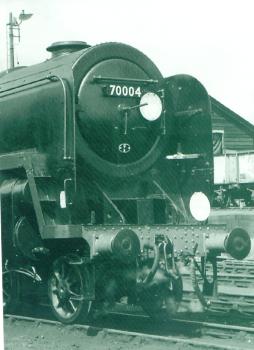 |
A
History of
Britannia Class (7p) |

|
Following rail nationalisation in
1948 British Railways commenced design of the first of its standard class locomotives.
“Britannia” entered service in January 1951 speedily followed by others including “William Shakespeare” which was exhibited at the Festival of Britain in that year.
Officially designated a
mixed traffic locomotive,
the Britannia class was
primarily allocated to
express passenger duties
|

'Britannia'
posing as 'William Shakespeare' carrying the Golden Arrow headboard.
– Brunswick green, lined in orange and black, soon replacing the black livery in which the engine was originally out-shopped.
Designed by R. A. Riddles, the Britannia class were the first and last British Railways standard class steam locomotives to run in service.
|
Its design was rugged, reflecting a post-war austerity, yet its pedigree could be traced back to the LMS Duchess class Pacifics of the late 1930’s.
With economy of build and maintenance in mind, the Britannias were built with just two cylinders compared to the three and four cylinders of the Royal Scots and Castles.
The first batch of twenty-five locomotives were produced in 1951 and numbered 70000-70024 and sent to work on Eastern, Western and Southern Regions.
On the Eastern line the locomotives were well-liked, replacing the old Sandringham 4-6-0’s.
Southern Region received three locomotives which were allocated to Stewarts Lane (London) to work the heavy “Golden Arrow” boat trains. These engines included “William Shakespeare” and “Iron Duke”, often considered to be two of the finest locomotives of the class.
A further twenty engines were delivered in 1952/53 and distributed to the
Cardiff Canton Depot and London Midland region.
The final batch of ten locomotives were delivered in 1954 and sent to Scotland – shedded at Polmadie (Glasgow). These were equipped with the curved-sided 9 ton tender as opposed to the original 7 ton. In
addition to providing a greater capacity the shape of the new tender produced a smoother airflow around the cab
creating less swirling dust and dirt.
Despite their all up weight of over 94 tons the Britannias enjoyed wide route availability due to an axle loading of just over 20 tons. With a wheelbase of 58' 3" it could also be accommodated on a 60ft turntable.
The tractive effort was 32150 lb compared to a re-built Royal Scot and Castle at 33150 ad 31625 respectively.
However, the 4-6-0 designs placed more of their weight on to their driving wheels and the Britannias needed a sensitive hand on the regulator to guarantee getting away without wheel slip.
Perhaps hard riding and noisy, the Britannias were fast and economical. The class were the last to be withdrawn in the face of dieselisation providing the greatest testimony to these fine locomotives.
Two of these proud Pacifics have been preserved – “Britannia” (70000) in private ownership and “Oliver Cromwell” (70013) at Bressingham Gardens at
Diss Norfolk.
|
|